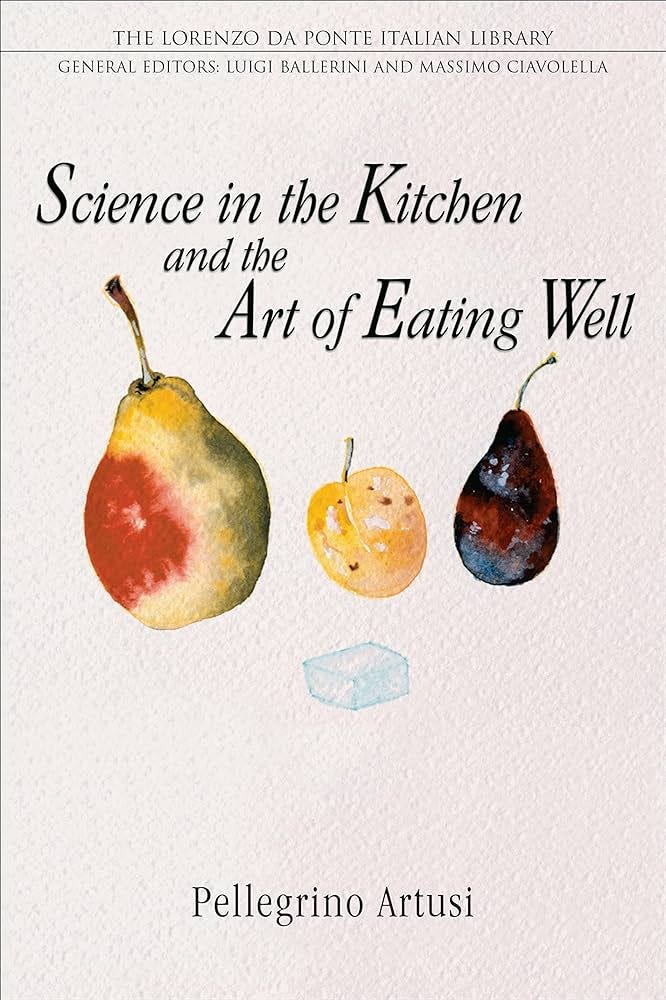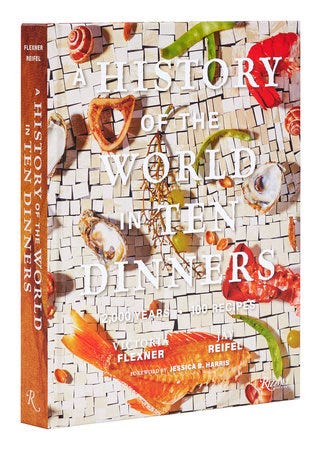All of August I’m writing about the tomato. Its origins in the Americas, its history, its colonization, and its post-1492 life as a symbol of Italian cuisine. You can find part 1 here.
In 1692, an Italian man named Antoni Latini put pen to paper and recorded the first recipe for tomato sauce. He wrote,
Take a half-dozen mature tomatoes, then place on the fire to roast, and when they are roasted, peel them carefully and chop them very finely with a knife, and onions chopped very finely to taste, chili also very finely chopped and a small quantity of (wild) thyme. Mix everything together and dress it with a little salt, oil and vinegar, which will make a very tasty sauce for boiled meat or other things.
Is this the first recipe for tomato sauce that ever existed? Probably not. But it’s the first written one we know of, and the progenitor of every other recipe for Nona’s sauce that would follow in the centuries to come. It was published in Latini’s 17th century culinary treatise Lo scalco alla moderna, and even though it is over three hundred years old, it's remarkably similar to a recipe we would find today.

What is different about Latini’s tomato sauce from a contemporary one (which would definitely go on pasta), is that it is not intended for pasta – but rather meat and “other things.” I know from personal experience that Latini’s sauce is very good served over lamb chops. It might come as a surprise, but at this point in Italy’s timeline of gustatory history, pasta was served with butter, cheese and maybe a little bit of grated nutmeg. When Latini wrote his recipe, tomatoes were still very new to Europe.
The tomato made its way from Mexico to Spain in the early 16th century. One of the oldest commodities to be extracted from the New World by European colonizers. At first the fruit was grown mainly in monastery gardens – sort of the botanical test kitchens of their time. Eventually, the tomato became a curiosity for the rich, who used the plant as a decorative object (a bit like the pineapple).

Our tomato champion, Latini, worked as a chef for a cardinal in Rome and later for the Spanish Viceroy in Naples. It was likely during his time working for the Spanish Viceroy that he was introduced to the tomato and began to cook with it. Hence the name for his recipe, “tomato sauce in the Spanish style.”
So at what point did the tomato go from elite delicacy to staple of the common man? Was it hunger that drove Italians to adopt the tomato as a beloved national ingredient? Other foods from the New World, like potatoes and corn, faced skepticism at first. But ultimately hunger would drive Europeans to eat these foods on a large scale. Europe was in the midst of a Little Ice Age from about 1400 to 1700, and economic historian Brian Murphy has noted how relentless the subsequent failing harvest would have been,
The harvests of the years 1481-82, 1502, 1520-1, 1526-29, 1531-32, 1535, 1545, 1549-51, 1555-56, 1562, 1573, 1585-86, 1594-97, 1608, 1612-22, 1621-22, 1630, and 1637, could be said to have been such that the average wage earner with a family to support can have had little left over after buying bread.
Entire generations would have known hunger intimately. Ironically, the global cooling which caused abysmal harvests and widespread starvation in Europe was likely triggered by the genocide of native peoples in the Americas. The death of about 90% of the American indigenous population led to massive tracts of agricultural land being untended, “allowing the land to become overgrown with trees and other new vegetation…the regrowth soaked up enough carbon dioxide from the atmosphere to actually cool the planet.”
Of course, the Spanish and Portuguese had no idea their American genocide was starving people back home. Given the extent of the famine, it is no surprise that authorities encouraged the growth and consumption of potatoes once they were found to grow well on European soil. But the tomato does not contain the same amount of calories – it could not feed the starving peasants of Europe like the humble spud did. The adoption of the tomato was less about nutrition, and more about perception.
Lisa Lowe would call it the fetishism of colonial commodities. Marx would say it’s about the production of value through the relationship of exchange (can you believe I made it 8 months with this newsletter without quoting Marx?) I’d say the tomato was (and is) valued because of what it is perceived to represent.
The land the tomato came from was inherently exotic to Medieval Europeans. It was a place beyond the borders of their known world. It was a mysterious fruit from a mysterious place. The tomato’s early designation as a ‘golden apple’ or pommi d’oro (or ‘love apple’) by the Italians encapsulates the value attributed to it. It was as precious as gold.
Perception of value. It can make something that is not rare, seem rare. It is why Medieval Europeans were obsessed with spices from Asia. It’s why they would pay ludicrous sums to sprinkle nutmeg from Indonesia in their wine and black pepper from India on their roast meats. It’s why Columbus set sail in 1492, named Hispaniola the ‘West Indies’ and the people who lived there ‘Indians.’ It’s why, a few centuries later, English aristocrats would spend thousands to rent a pineapple as a centerpiece for their dinner parties. It’s why there are waitlists for Birkin handbags today.
Eventually however, even the most expensive, coveted, elite status symbol items – make their way down to the bargain bins where the rest of humanity shops.
For centuries Italy had been the battleground of various foreign powers; from the French, to the Swiss, the Spaniards, to the Germans. Rivalries between the city-states only increased internal disunity. But then in the 16th century, humanist writings of the Renaissance began to sow the aspirational seeds for Italian nationhood.
In Niccolò Machiavelli’s The Prince he implores, “Italians to unite under the leadership of a Medici prince, to expel the barbarians from their homeland.” Machiavelli wanted his fellow Italians to see that they, “no longer controlled their destiny,” and that, “their fate and fortunes were decided in foreign capitals.”
Sixteen years later in 1548, Milanese scholar (and satirist) Ortensio Lando proposed a
“gastronomic voyage in Italy” in his Commentario delle più notabili e mostruose cose d'Italia e altri luoghi, to demonstrate what Italians shared culturally. It is a kind of guidebook, which demonstrates that even though regional cuisines varied from one another throughout the peninsula, there were shared basic characteristics. Italian cuisine and Italian identity were becoming intertwined.
By the time Pellegrino Artusi’s cookbook La scienza in cucina e l’arte di mangiar bene (Science in the Kitchen and The Art of Eating Well) was published in 1891, tomatoes were no longer a food of the elite. Published just thirty years after the unification of Italy, it became an instant classic. It details recipes for all the most loved regional dishes but instead of grouping them according to province, Artusi organized the dishes according to broad culinary categories, like “Soups and Pastas with Broth,” “Fried Foods,” and “Pastry, Cakes and Sweets,” unifying diverse regional dishes under the grand new standard of ‘Italian Cuisine.’
The tomato is found throughout La Scienza. Artusi even offers up a pretty A+ dad joke when he writes about the nosey priest named ‘Don Pomodoro’ because he gets into everything. By 1891 Italians had started putting tomato sauce on pasta, and spaghetti was becoming a kind of national dish. Apparently, Giuseppe Garibaldi (revolutionary republican of the 19th century who helped to unify Italy), proclaimed, “It will be spaghetti, I swear to you, that unifies Italy.”

Our national origin stories are supposed to serve as the mythic basis of our identities. But the thing about identity is that, more often than not, it doesn’t originate in our origin stories.
Take the monuments that decorate our cities. They are supposed to represent our history. To give us visual reminders of our past. But the intended meaning behind these monuments gets lost in day-to-day life. The equestrian statue becomes the spot where teenagers smoke pot after dark. The fountain becomes a place for romantic strolls. The memorial to a war hero from long long ago becomes the site of protest for a new political movement.
Identity stems from daily life. The exchanges. The events. The people. The food. In Italy it was a shared sense of culinary heritage that strengthened the ties of togetherness and helped to create a singular identity made of diverse parts. The tomato - of all things - played an indispensable role in this process. By the turn of the 20th Century every trace of the tomato’s origin story as a plant domesticated by the Aztecs, had been completely erased. In its place il Tricolore grew.
Fascism was just coming to the fore in Italy when poet Filippo Tomasso Marinetti started il Movimento Futurista in 1909 – a movement which glorified modernity and sought to ‘liberate’ Italy from its past. In 1918 Marinetti founded a Futurist political party (Partito Politico Futurista) which would later merge with Benito Mussolini’s Fascist Party — and Marinetti would remain close to Mussolini until his death in 1944 (though historians remain divided on Marinetti’s true political motivations). Arguably, his most bizarre act would be the creation of The Futurist Cookbook in 1932 which as food writer Demet Guzey has described, “banned forks and knives, incorporated perfume and music, and often required skills in chemistry and sculpture.” The recipes are rooted in Marinetti’s nationalism but also read as creative pranks, political and social commentaries disguised as food.

Marinetti deplored pasta arguing it made Italians lazy and called for its replacement with rice and grain. He was virulently against the use of all foreign foods and foreign food names – yet he did not abandon the tomato. In the place of spaghetti with tomato sauce, he suggests Italians eat as the celestial do, “the angels in paradise eat only vermicelli with tomato sauce.”
Whether Marinetti knew the Mexican origin of the tomato or not, is unknown. Perhaps he chose to ignore it. What is crucial is that for Marinetti tomatoes were a symbol of the Italian nation. And when an Italian fascist describes vermicelli and tomatoes as foods of the gods – we know tomatoes have become Italian.
Edible History is a reader supported newsletter. To support my work and to gain access to the full archive of posts (each month paid subscribers receive additional edible histories and recipes in their inbox) consider upgrading to become a paid subscriber.
There’s still time to place orders for the Edible History X MackBecks jewelry collaboration! Oyster bolos, pineapple pinsand Anthora coffee cups inspired by this newsletter are all available here 🍍🦪☕️

Like what you’re reading? Get a copy of my book, A History of The World in Ten Dinners (Rizzoli) available here and here.









I love this- I live in Italy and sometimes remind people who believe they have the monopoly on tomato sauce that tomatoes are from in fact originally from south america...
Fantastic research! Many people wouldn't believe that the tomato was only commonly incorporated to Italian recipies 150 years ago. I love the history of ingredients, it always surprises you!